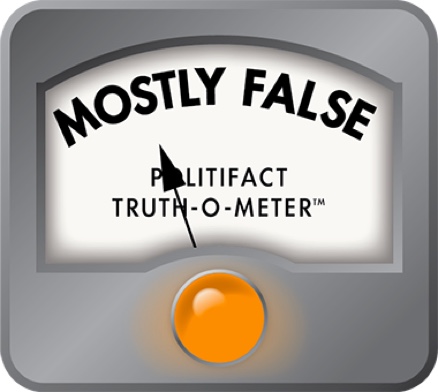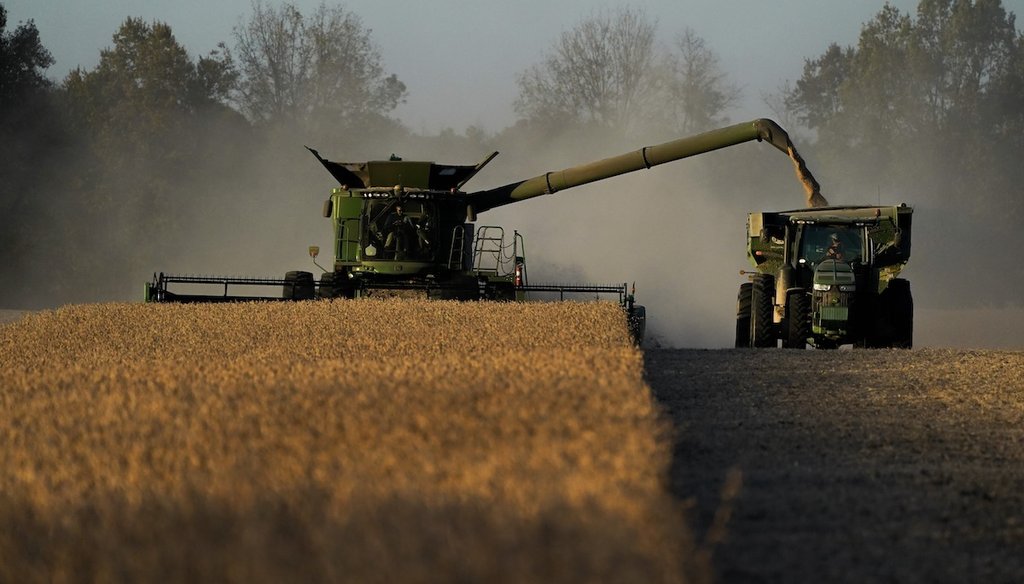

Our only agenda is to publish the truth so you can be an informed participant in democracy.
We need your help.


A combine is shown harvesting soybeans on Nov. 8, 2023, in Lynnville, Ky. (AP)
In fiscal year 2020, President Donald Trump’s last full fiscal year in office during his first term, the U.S. Department of Agriculture reported a trade deficit of $3.7 billion.
The most current data for agriculture exports, from fiscal year 2024 that ended in September, shows a $31.8 billion trade deficit. The $49 billion figure that Agriculture Secretary Brooke Rollins cited is a projection for fiscal year 2025, which mainly spans Trump’s current administration.
During Trump’s first term, the U.S. recorded its first agricultural trade deficit in nearly 60 years, USDA reported.
U.S. Agriculture Secretary Brooke Rollins blamed former President Joe Biden for the rising agricultural trade deficit, while defending President Donald Trump’s tariffs on nearly every country.
"In the last four years, we had an agriculture export deficit that increased from zero when President Trump left to $49 billion," Rollins said in an April 6 CNN interview. She was responding to host Jake Tapper’s question about uncertainty for U.S. farmers amid implementation of Trump’s tariffs.
Trump declared a 90-day pause on most of his tariffs April 9 after backlash and stock market declines. Trump did not pause a 125% tariff on China.
The agriculture trade deficit, when the value of imports exceeds the value of exports, has increased for several years. But Rollins' statement misleads by cherry picking data and blaming Biden and his policies.
The most current data for agriculture exports, from fiscal year 2024 that ended in September, shows a $31.8 billion trade deficit. The $49 billion figure that Rollins cited is a projection for fiscal year 2025, which mainly spans Trump’s current administration.
And the agricultural export deficit was not zero when Trump left office; it was $3.7 billion in fiscal year 2020, Trump’s last full fiscal year during his first term.
USDA did not respond to PolitiFact’s request for comment.
Agricultural economists said there are several reasons why the agricultural trade deficit has grown, and Trump’s tariffs during his first term is a major one.
In February, the Department of Agriculture published a report forecasting agricultural trade for fiscal year 2025, which started in October 2024. The report projected a $49 billion agricultural trade deficit, a record high. The previous record was set in fiscal year 2024.
Fiscal year 2025 covers about four months of Biden’s administration and about eight months of Trump’s current administration. Also, USDA updates its projections periodically throughout the year, so it’s unclear what the final trade deficit will be for fiscal year 2025 and whether Trump’s current tariffs will affect it.
During Trump’s first term, his administration gave U.S. farmers $28 billion in subsidies after tariffs on China decimated the U.S. agricultural export market. The New York Times reported March 31 that the current administration is considering whether to give emergency aid to farmers.
During her CNN interview, Rollins said USDA "will make sure that we have the funds" for farmer subsidies if needed.
Historically, the U.S. had an agricultural trade surplus. But in fiscal year 2019, during Trump’s first term, the U.S. recorded its first agricultural trade deficit in nearly 60 years, according to the USDA report.
Since fiscal year 2019, the U.S. has fluctuated between an agricultural trade deficit and surplus. In fiscal years 2019 and 2020, USDA recorded trade deficits of $1.3 billion and $3.7 billion, respectively.
In the first two years of the Biden administration — fiscal years 2021 and 2022 — USDA recorded trade surpluses. In the last two years of the Biden administration, it moved into record-high trade deficits.
There are two ways to potentially reach Rollins’ number of a zero trade deficit, both misleading.
One way is to consider the fiscal year when Trump left office. Fiscal year 2021, which included the last few months of Trump’s first administration, had a trade surplus. But Biden was president during most of that year.
The other way is to look at the calendar year instead of the fiscal year. In the 2020 calendar year, Trump’s last full year in office during his first term, USDA reported a $3.4 billion agricultural trade surplus. But Rollins’ $49 billion deficit figure aimed at Biden pointed to a fiscal year. Using a fiscal year to blame Biden for a trade deficit and a calendar year to praise Trump for a trade surplus is disingenuous.
Agricultural economists said the agricultural trade deficit has increased for several reasons, including Trump’s first term tariffs, the strength of the U.S. dollar and U.S. consumer demand for imported goods.
Tariffs on China during Trump’s first term
In 2018, Trump implemented tariffs against China. China retaliated by shifting its imports away from the U.S., producing goods domestically or trading with other countries. For example, instead of importing soybeans from the U.S., China began importing from Brazil.
That "started the path to (agricultural) deficits," William Alan Reinsch, an international trade expert at Center for Strategic and International Studies, said.
The strength of the U.S. dollar
The U.S. dollar’s value has been rising since the Great Recession waned in 2011. That means its exchange rate is higher against other currencies.
A strong dollar can benefit Americans traveling overseas, because their dollars buy more local currency. It also makes imports relatively cheaper. But the strong dollar has also contributed to the agricultural trade deficit, Reinsch said, because U.S. exports cost more overseas.
"The strong US dollar and weakened foreign currencies are making it more difficult for countries to buy US exports," Betty Resnick, an agricultural economist, wrote in a February report.
U.S. consumer demand for imported goods
U.S. consumers have strong demand for coffee, year-round access to fruit and vegetables and alcohol. Those are products the U.S. imports in part because they aren’t domestically grown in large enough quantities to meet demand. Increased demand for those products in the U.S. means they have to be imported. And increased imports can affect the trade deficit.
According to the USDA projection, agricultural imports are expected to increase by $4 billion in fiscal year 2025 compared with 2024.
In response to Trump’s tariffs, China announced an 84% retaliatory tariff on U.S. goods starting April 10.
"The major effect will come if other countries retaliate against our tariffs," Reinsch said, before China announced retaliatory tariffs. "Agriculture is usually a prime target when that happens, and, given the additional tariffs being placed on China, you can expect most trade with China to be effectively cut off because of their retaliation."
Trade relation disruptions as a result of Trump’s tariffs are likely to negatively affect U.S. farmers, the International Food Policy Research Institute, a think tank working to reduce poverty and end hunger, said in a report. The group said other countries such as Brazil and Argentina will likely step in to fill the gaps to sell products the U.S. usually exports, such as soybeans, beef and corn.
"This shift is expected to reshape the global agricultural market," the report said.
Rollins said, "In the last four years, we had an agriculture export deficit that increased from zero when President Trump left to $49 billion."
The agricultural trade deficit was not zero when Trump left office. In fiscal year 2021, Trump’s last full fiscal year in office during his first term, USDA recorded a $3.7 billion trade deficit. During Trump’s first term, the U.S. recorded its first agricultural trade deficit in nearly 60 years, in part because of tariffs he imposed on China.
The most current data for agriculture exports, from fiscal year 2024 that ended in September, shows a $31.8 billion trade deficit. The $49 billion figure that Rollins cited is a projection for fiscal year 2025, which mostly spans Trump’s current administration.
Attributing changes in the agricultural trade deficit to the president alone is misleading. Some factors that affect the trade deficit are out of the president’s control, such as consumer demand.
Rollins’ statement includes an element of truth because in the last two years of the Biden administration, agriculture trade moved into record-high deficits. But it ignores critical facts that would give a different impression.
We rate the statement Mostly False.
CNN, Amid market meltdown, Trump cabinet secretary defends tariffs as 'new American order', April 6, 2025
CNN, The stock market is having another wild day after Trump signals apparent shift in trade policy, April 9, 2025
Rapid Response 47, Post, April 9, 2025
U.S. Department of Agriculture, Outlook for U.S. Agricultural Trade: February 2025, Feb. 27, 2025
Center for Strategic and International Studies, Food for Thought, Sept. 3, 2024
U.S. Department of Agriculture, Foreign Agricultural Trade of the United States (FATUS) - Calendar year, accessed April 9, 2025
Forbes, Trump Tariff Aid To Farmers Cost More Than U.S. Nuclear Forces, Jan. 21, 2020
Farm Bureau, Agricultural Exports 101, Feb. 12, 2025
PolitiFact, Donald Trump incorrect that U.S. dollar is strongest it's ever been, Aug. 22, 2019
Investopedia, What Do the Terms "Weak Dollar" and "Strong Dollar" Mean?, Dec. 24, 2023
CNBC, China slaps 84% retaliatory tariffs on U.S. goods in response to Trump, April 9, 2025
International Food Policy Research Institute, How ‘reciprocal tariffs’ harm agricultural trade, April 8, 2025
The Washington Post, Rollins misfires with claim Trump left Biden an agriculture trade surplus, April, 1, 2025
Texas Farm Bureau, USDA raises 2025 agricultural trade deficit, Dec. 31, 2024
KCRW, Wage disparities and higher valued imports help explain the current agricultural trade deficit, March 14, 2025
Farm Bureau, Understanding the New Tariffs, April 4, 2025
Fresh Plaza, U.S. faces $49B agricultural trade deficit as imports rise, April 8, 2025
Agriculture Dive, Record ag trade deficit to widen in fiscal 2025: USDA, Aug. 28, 2024
SeedWorld, USDA Projects $45.5 Billion Agricultural Trade Deficit for 2025, Dec. 2, 2024
Progressive Farmer, Ag Trade Deficit Grows, Dec. 2, 2024
Bloomberg, Trade Wars Won’t Make American Farming Great Again, March 12, 2025
Agriculture Dive, Record agriculture trade deficit expected to keep growing, Nov. 27, 2024
U.S. Department of Agriculture, U.S. agricultural import values outpaced export values again in 2024, April 1, 2025
Farm Bureau, Record U.S. Agricultural Trade Deficit Forecasted to Keep Growing, June 20, 2024
National Hog Farmer, USDA projects $49 billion agricultural trade deficit in 2025, March 7, 2025
Email interview, William Alan Reinsch, Center for Strategic and International Studies, senior adviser and Scholl Chair Emeritus, Economics Program and Scholl Chair in International Business, April 8, 2025
In a world of wild talk and fake news, help us stand up for the facts.
